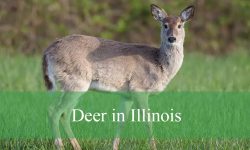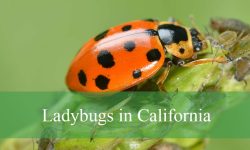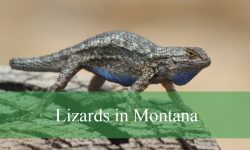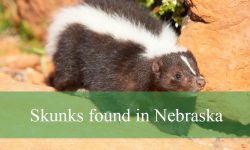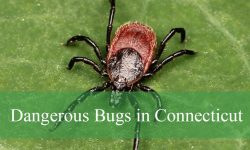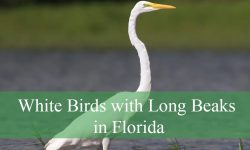Texas is a true haven for birdwatchers who are drawn to bright colors and lively songs. Few experiences compare to spotting a yellow-breasted bird perched in the morning light. From the bold Western Kingbird soaring over open ranchlands to the golden Prothonotary Warbler glowing beside quiet rivers, every species adds beauty to the state’s rich birdlife.
Across Texas, every landscape tells a different birding story. The coastal marshes echo with the calls of Common Yellowthroats, the pine forests shimmer with Pine Warblers, and the brushlands of South Texas glow with the presence of Altamira Orioles. Each region holds its own unique combination of color, sound, and motion.
Birdwatching in Texas is more than a pastime. It is an invitation to slow down, listen closely, and appreciate the wild spirit of nature. Every sighting of a yellow flash among the leaves reminds us of how alive and beautiful the natural world truly is.
Types of Birds with Yellow Breasts Found in Texas
Western Meadowlark (Sturnella neglecta)
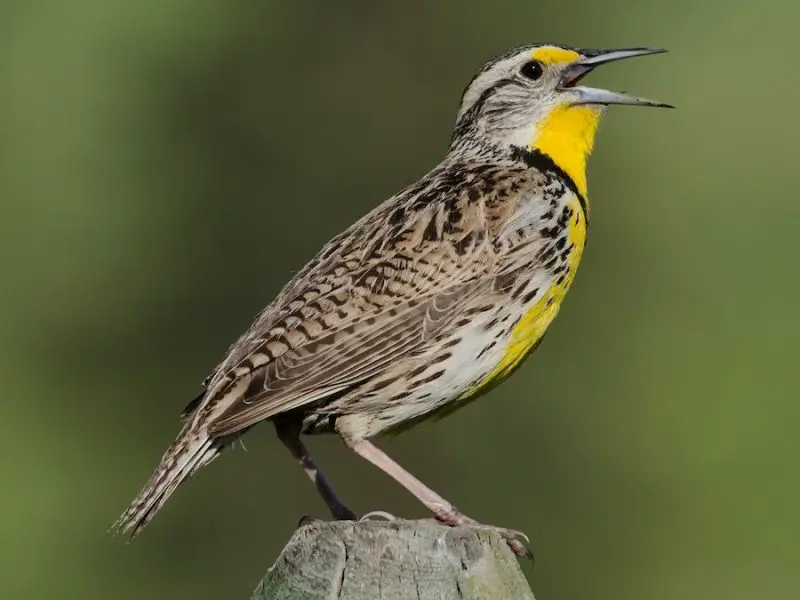
The Western Meadowlark is a striking bird with a bright yellow breast marked by a bold black “V” across its chest. Its upperparts are mottled brown and black, providing excellent camouflage in grasslands. This species is similar in size to a robin, measuring about 8.5 inches long with a wingspan of around 16 inches. Its bill is long and pointed, perfectly adapted for probing soil and grass for insects.
It can be recognized by its distinctive flute-like song, which is rich, melodic, and easily distinguishable from the Eastern Meadowlark. During flight, it shows white outer tail feathers and rounded wings. Males are often seen singing from fence posts or tall grasses to defend their territories and attract mates.
Western Meadowlarks are ground feeders, eating mainly insects in summer and seeds in winter. They are known for their secretive nesting behavior, building well-hidden nests in dense grasses. Their calm, deliberate movements and tendency to freeze when approached make them challenging to spot in tall vegetation.
In Texas, Western Meadowlarks are found primarily in the Panhandle and western regions, favoring open prairies, grasslands, and agricultural fields. They are most common in winter when populations increase as northern birds migrate southward.
Eastern Meadowlark (Sturnella magna)
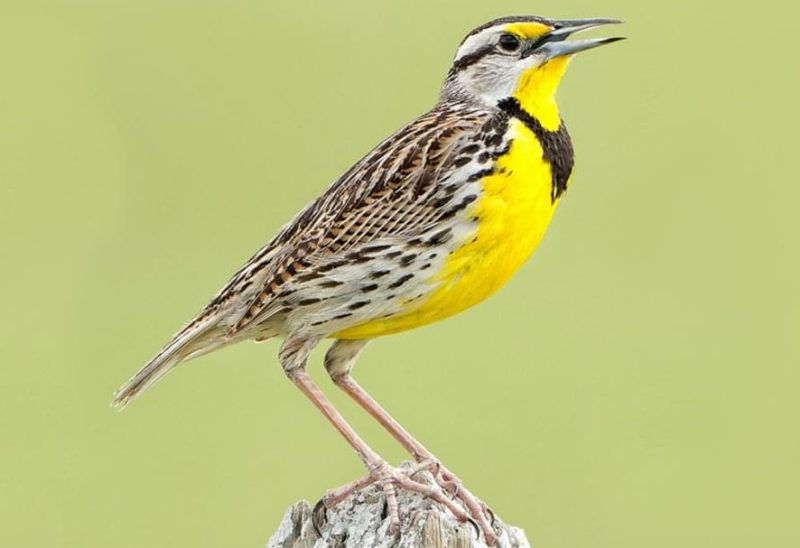
The Eastern Meadowlark also features a yellow breast with a black “V,” similar to its western relative, but its song is a clear, whistled “spring-of-the-year” that differs in tone and pattern. Its plumage is slightly darker with more defined streaking on the back. Adults typically reach lengths of about 9 inches with a wingspan of 13 to 16 inches.
It is best recognized by its sharp, clean whistles and tendency to perch on low fences or posts. In flight, its short, rounded wings and white outer tail feathers are noticeable. Males often sing persistently from exposed perches during breeding season to establish dominance.
Eastern Meadowlarks primarily feed on insects, grasshoppers, and seeds. They forage mostly on the ground, walking slowly and methodically through grass. Nests are dome-shaped and well concealed among thick vegetation, built from grass and plant stems.
In Texas, Eastern Meadowlarks are found throughout the eastern and central parts of the state, thriving in pastures, hayfields, and prairies. They are year-round residents, although populations may increase slightly during migration periods.
Yellow Warbler (Setophaga petechia)
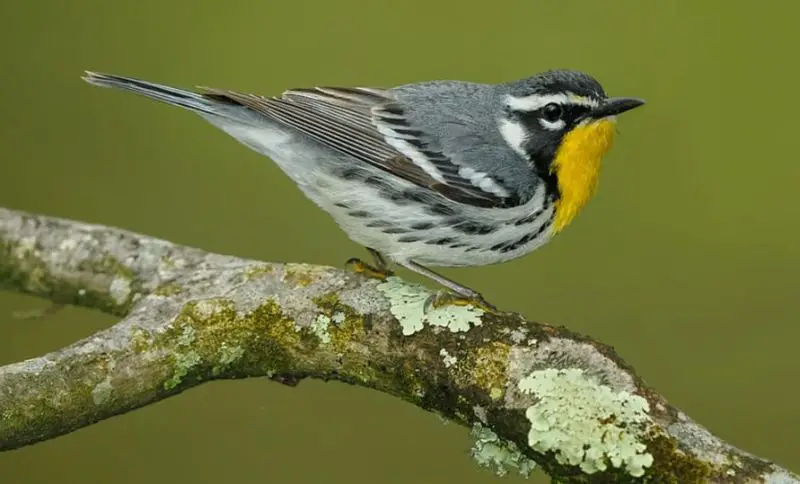
The Yellow Warbler is a small, vibrant bird covered almost entirely in golden-yellow plumage. Males are brighter, with reddish streaks on their breasts, while females are paler and lack the heavy markings. They measure about 4.7 to 5 inches long, with a slender build and a sharp, pointed bill.
This bird is easy to recognize by its sweet, musical song described as “sweet-sweet-sweet, I’m so sweet.” Its constant movement among willows and shrubs makes it a lively presence during spring migration. The Yellow Warbler’s cheerful song and bright color make it one of the most noticeable warblers in Texas during migration.
Yellow Warblers feed primarily on insects, including caterpillars, beetles, and spiders. They are active foragers, flitting through foliage and occasionally catching flying insects mid-air. They also eat small amounts of berries during late summer.
In Texas, Yellow Warblers appear mainly during spring and fall migrations. They frequent riparian woodlands, shrubby areas near streams, and forest edges. Breeding populations are more common in northern regions, while most pass through the state en route to nesting grounds farther north.
Prothonotary Warbler (Protonotaria citrea)
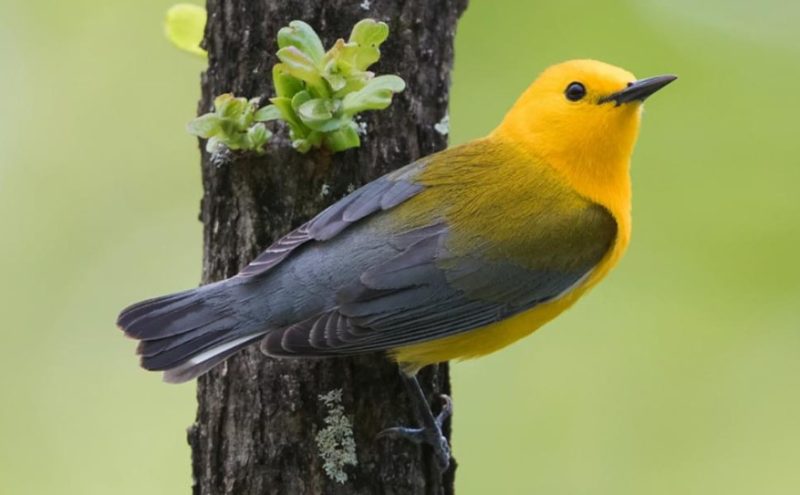
The Prothonotary Warbler stands out with its golden-yellow head and breast contrasted by blue-gray wings and back. Its belly is whitish, and its large black eyes give it an alert expression. It measures around 5.5 inches long, slightly larger than most warblers, with a strong bill adapted for insect foraging.
This warbler is most easily recognized by its glowing yellow plumage and loud, ringing song of “sweet-sweet-sweet-sweet.” It is often seen hopping along tree trunks and branches near water, searching for insects and small invertebrates. Its movement resembles that of a nuthatch or creeper.
Prothonotary Warblers nest in cavities, a rare trait among warblers. They prefer old woodpecker holes or artificial nest boxes placed near water. Their diet consists mainly of insects, snails, and aquatic larvae, which they find along flooded forests and swamps.
In Texas, they are found in the eastern regions, especially in forested wetlands, cypress-tupelo swamps, and riverside woods. They are summer residents and migrate to Central and South America during winter.
Common Yellowthroat (Geothlypis trichas)
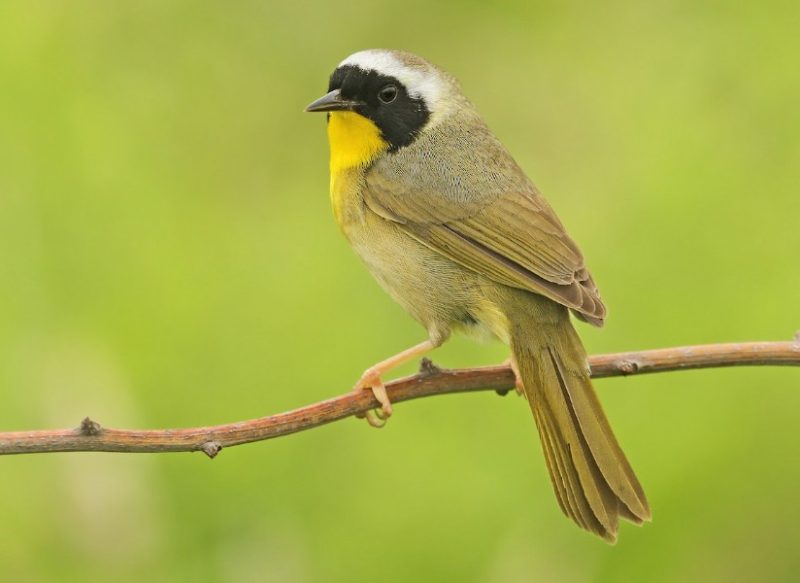
The Common Yellowthroat is a small, active warbler recognized by the male’s striking black mask bordered by white and its bright yellow throat and breast. Females lack the mask and are duller olive-yellow overall. This bird is about 5 inches long, with a rounded tail and compact body.
It can be identified by its distinctive “witchety-witchety-witchety” song and secretive behavior. Unlike many warblers that stay high in trees, the Common Yellowthroat prefers low vegetation, darting through reeds and grasses. Its energetic movements and frequent tail flicks are characteristic.
These warblers feed mostly on insects, spiders, and small larvae, gleaning prey from leaves or catching them in short flights. During breeding season, males become territorial and often sing from exposed perches to attract mates.
In Texas, the Common Yellowthroat is widespread, especially in wetlands, marshes, and areas with dense shrubs. They are found statewide during migration, while breeding populations remain in eastern and central regions through summer.
Hooded Warbler (Setophaga citrina)
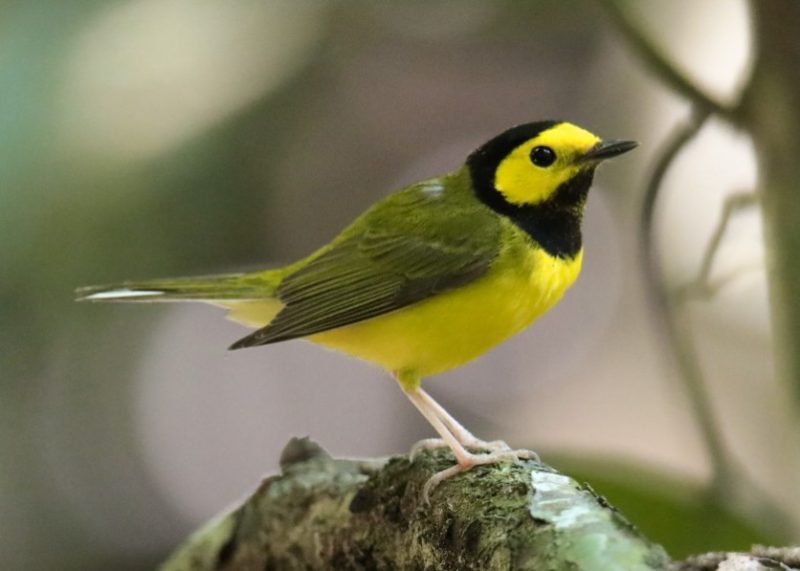
The Hooded Warbler is an elegant songbird with a brilliant yellow face and underparts contrasted by a striking black hood and throat in males. Females and juveniles have a similar pattern but with less black around the head. Measuring about 5 inches long, it has a rounded tail that flashes white outer feathers when it flits through the forest understory.
This species is best recognized by its distinctive, ringing song often described as “ta-wit ta-wit ta-wit tee-yo.” Hooded Warblers are active and curious, moving rapidly through foliage while hunting insects. Their sharp black mask and bright yellow color make them stand out in shaded woodlands.
They feed mainly on insects and spiders, capturing prey by darting into the air or gleaning from leaves. During breeding, males defend territories vigorously, chasing away intruders with quick, agile movements. Their nests are cup-shaped and hidden low in shrubs or saplings.
In Texas, Hooded Warblers are primarily found in the eastern part of the state, especially in moist woodlands and forest edges. They breed locally in East Texas and migrate through the region during spring and fall, heading to Central America and the Caribbean for winter.
Pine Warbler (Setophaga pinus)
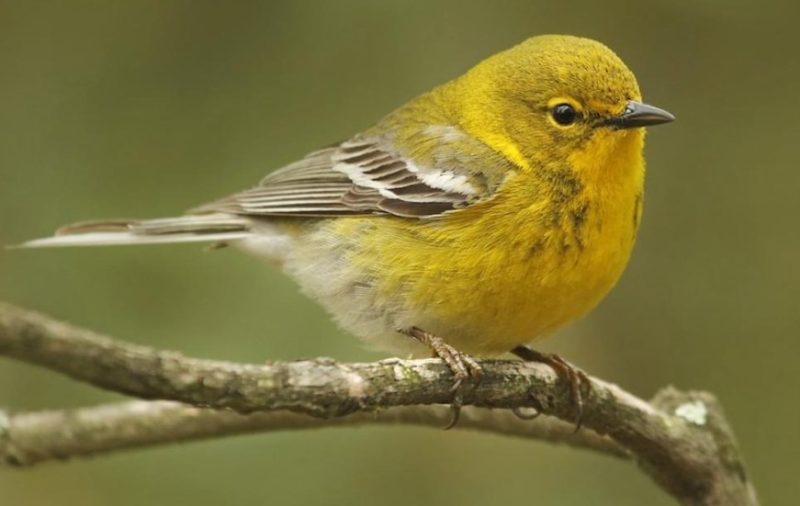
The Pine Warbler is a medium-sized songbird with a yellow breast and olive-green back, perfectly blending into the pine forests it inhabits. Males are bright yellow, while females and juveniles are duller with grayish tones. It measures about 5.5 inches in length and has a slightly longer bill than many other warblers.
This bird can be identified by its simple, musical trill that resembles a chipping sparrow’s song. It often forages high in pine canopies but also descends to the ground, especially in winter, to feed on seeds. Its association with pine trees makes it one of the easier warblers to identify by habitat.
Pine Warblers eat insects, caterpillars, beetles, and seeds, and they are one of the few warblers that regularly visit feeders for suet or millet during colder months. Their nests are neatly built in pine branches, usually high off the ground.
In Texas, Pine Warblers are most common in the eastern pine forests and are year-round residents in many areas. They prefer mature pine stands, mixed woodlands, and open groves with a dense canopy.
Wilson’s Warbler (Cardellina pusilla)
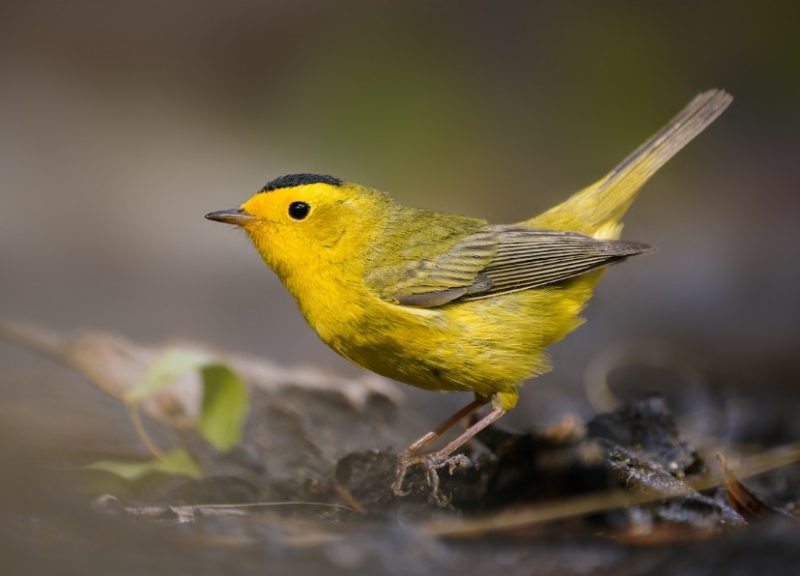
The Wilson’s Warbler is a tiny, lively bird with bright yellow underparts and a greenish back. The male has a distinctive small black cap that contrasts with its yellow face and body, while females may show only faint traces of the cap. It measures about 4.5 inches long and has a slender, agile build.
This warbler is easily recognized by its energetic behavior and constant movement as it flits among shrubs and low trees. Its song is a rapid, cheerful series of notes that seem to bounce upward in pitch. Wilson’s Warblers are often seen during migration, foraging restlessly in thickets and gardens.
Their diet consists mainly of insects and spiders, which they catch by gleaning from foliage or making quick aerial sallies. They are active feeders, often flicking their tails and wings while searching for prey. During migration, they can be found at all elevations, from lowlands to mountain forests.
In Texas, Wilson’s Warblers are common spring and fall migrants across the state. They frequent riparian corridors, shrublands, and wooded areas near water, stopping briefly before continuing to breeding grounds in the north or wintering areas in Mexico and Central America.
Audubon’s Warbler (Setophaga coronata auduboni)
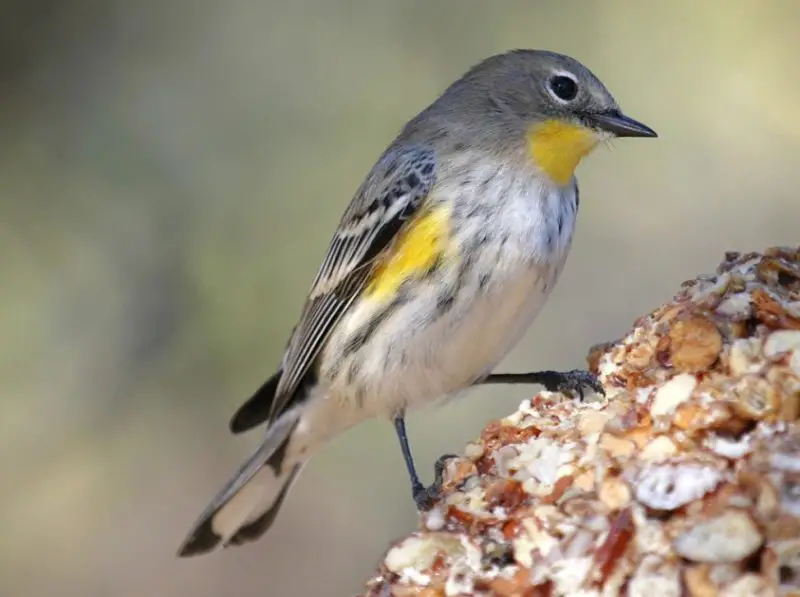
Audubon’s Warbler, a subspecies of the Yellow-rumped Warbler, is notable for its bright yellow throat, rump, and sides, contrasted with a gray back and white wing patches. Males are strikingly patterned, while females and immatures are paler with less distinct markings. It measures around 5.5 inches in length and has a sturdy build.
This bird is highly adaptable and can be recognized by its sharp “chek” call and sweet, trilling song. It often flutters out from perches to catch flying insects or gleans them from leaves. During migration, large flocks can be seen moving through open forests and parks.
Audubon’s Warblers have a versatile diet, feeding on insects during summer and switching to berries in winter. Their ability to digest wax-coated berries allows them to remain farther north than most other warblers during cold seasons. They are active, social, and often mix with other small birds in flocks.
In Texas, Audubon’s Warblers are mainly seen in the western and central regions during winter and migration. They inhabit open pine forests, mountain slopes, and shrublands, especially in the Hill Country and Trans-Pecos regions.
Yellow-throated Warbler (Setophaga dominica)
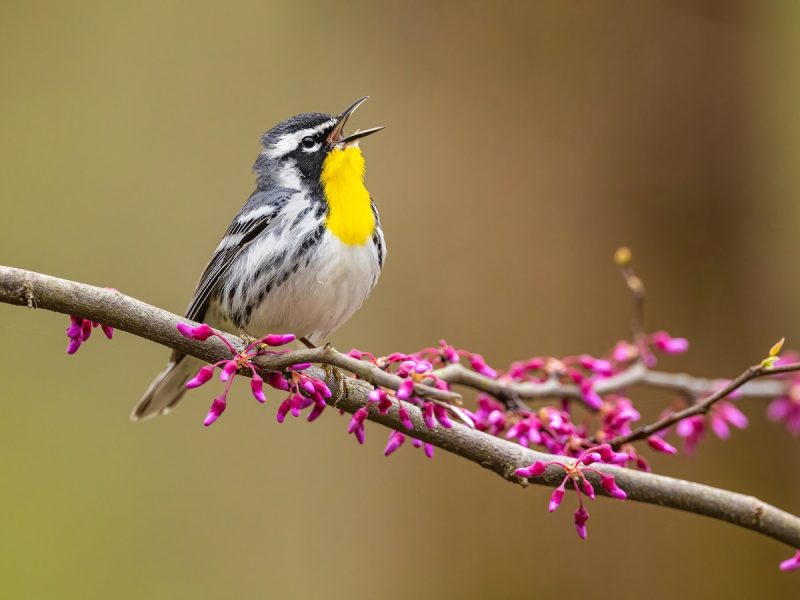
The Yellow-throated Warbler is a sleek, elegant bird with a bright yellow throat and breast, black streaks on its sides, and a white belly. Its gray upperparts and bold black-and-white facial pattern make it one of the most distinctive warblers. It measures about 5 inches long and often appears slightly elongated due to its long bill and tail.
It is easily recognized by its clear, sweet song and methodical foraging style. Unlike many warblers, it often climbs along branches and tree trunks, similar to nuthatches, searching for insects hidden in bark crevices. Its calm, deliberate movements set it apart from the more restless species.
Yellow-throated Warblers feed on insects, caterpillars, spiders, and occasionally small berries. They build their nests high in trees, often in Spanish moss or pine needles, well concealed among dense foliage. During breeding, males sing persistently to defend territories.
In Texas, the Yellow-throated Warbler is most common in the eastern and southeastern parts of the state. It favors mature pine forests, cypress swamps, and riverside woodlands. Many remain year-round along the Gulf Coast, while northern breeders migrate through in spring and fall.
Yellow-breasted Chat (Icteria virens)
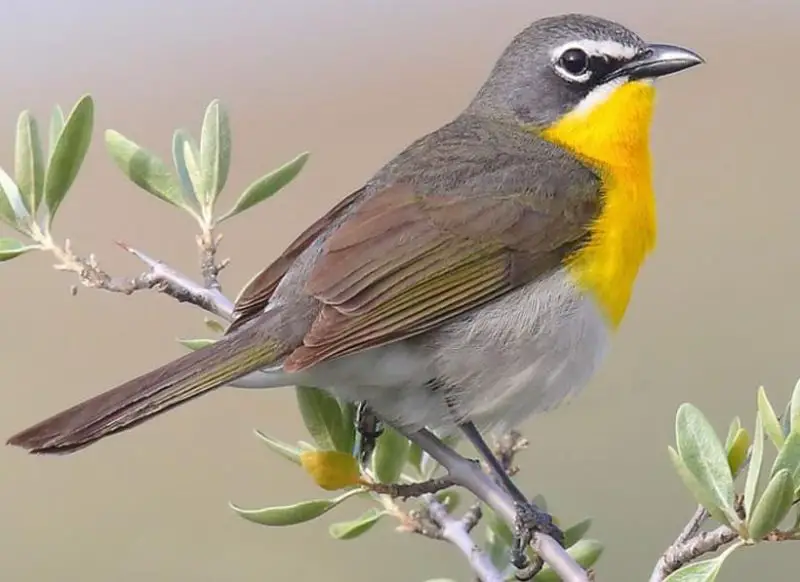
The Yellow-breasted Chat is a large, vibrant songbird with a bright yellow chest, olive-green back, and white belly. Its striking face pattern includes white “spectacles” and a strong black line through the eyes. Measuring about 7.5 inches long, it’s the largest member of the warbler family, often confusing observers due to its unique shape and behavior.
This bird is easily identified by its loud, varied song, which includes whistles, cackles, and harsh notes. Males often sing from exposed perches or perform fluttering display flights to attract mates. Unlike typical warblers, chats are secretive, skulking through dense thickets and rarely venturing into open spaces.
Yellow-breasted Chats feed mainly on insects and berries, foraging low in shrubs or trees. They are highly territorial during breeding season and can be quite vocal and defensive. Their strong flight and erratic behavior make them fascinating to watch once spotted.
In Texas, this species is a common summer resident throughout much of the state, especially in brushy areas, forest edges, and riparian zones. They migrate south to Mexico and Central America for the winter but can occasionally be seen in southern Texas year-round.
Scott’s Oriole (Icterus parisorum)
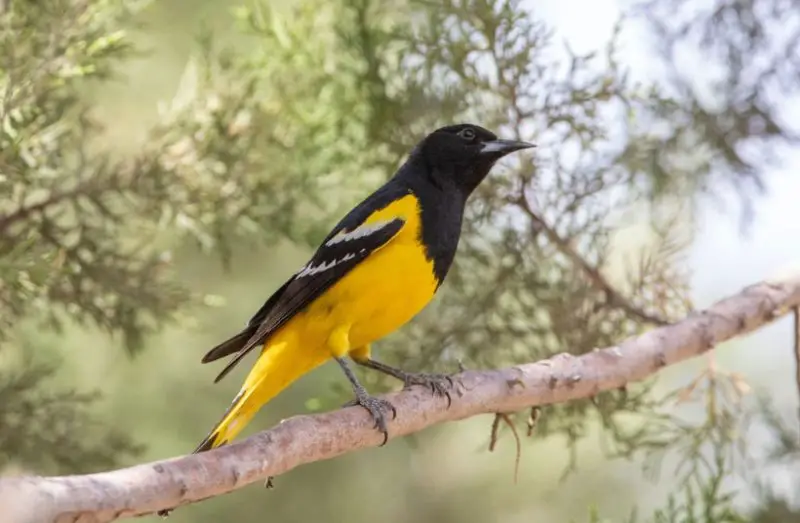
Scott’s Oriole is a stunning bird of the desert and mountain regions, known for its bright lemon-yellow belly and contrasting black head, back, and chest. Females are paler with olive-yellow tones and grayish backs. It’s a medium-sized oriole, about 9 inches long, with a slender body and long, pointed bill.
Its song is a series of rich, flutelike whistles, often heard echoing across rocky hillsides. Scott’s Orioles are deliberate in their movements, often perching high on yucca or agave stalks. Males are territorial during the breeding season, frequently singing from prominent perches to mark their range.
They feed primarily on insects, nectar, and fruit, and are known to pierce flowers to access nectar directly. Their cup-shaped nests are woven from plant fibers and often placed in yuccas or junipers. The species is well adapted to arid environments and shows great resilience to heat.
In Texas, Scott’s Oriole is found mainly in the western and southwestern regions, particularly in desert foothills, dry canyons, and scrublands. They are summer breeders in the Trans-Pecos and Hill Country areas, migrating south into Mexico for winter.
Orchard Oriole (Icterus spurius)
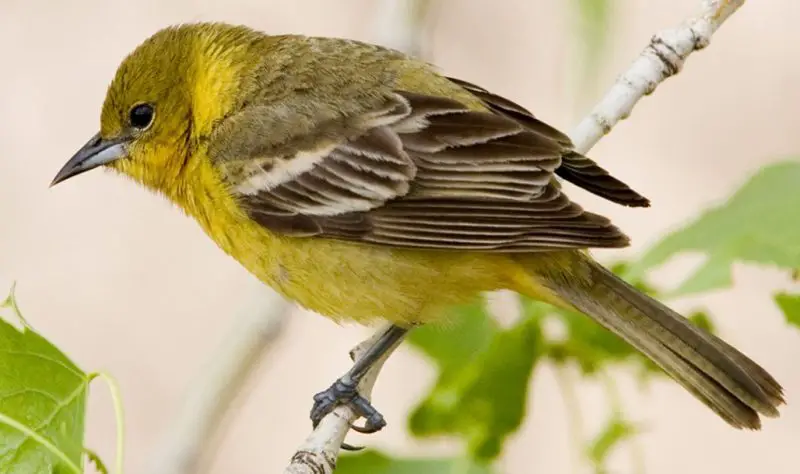
The Orchard Oriole is the smallest oriole in North America, distinguished by the adult male’s chestnut-red underparts and black head, wings, and back. Females and immatures are bright yellow-green with darker wings and white wing bars. Adults measure about 7 inches long, giving them a more delicate appearance than other orioles.
This species is often recognized by its fast, chattering song composed of sweet, whistled notes. Males are more vocal during breeding season, while females are quieter and more secretive. Orchard Orioles are agile and active, frequently seen flitting among trees in search of insects and fruit.
Their diet includes caterpillars, beetles, and ripe fruit, along with nectar during spring and summer. They build hanging pouch-like nests woven from grass, suspended from the tips of tree branches. They are among the earliest orioles to migrate south, leaving by late summer.
In Texas, Orchard Orioles are common summer residents across most of the state, especially in open woodlands, riverbanks, and suburban areas. They migrate to Central America for winter but are most abundant in eastern and central Texas during breeding season.
Altamira Oriole (Icterus gularis)
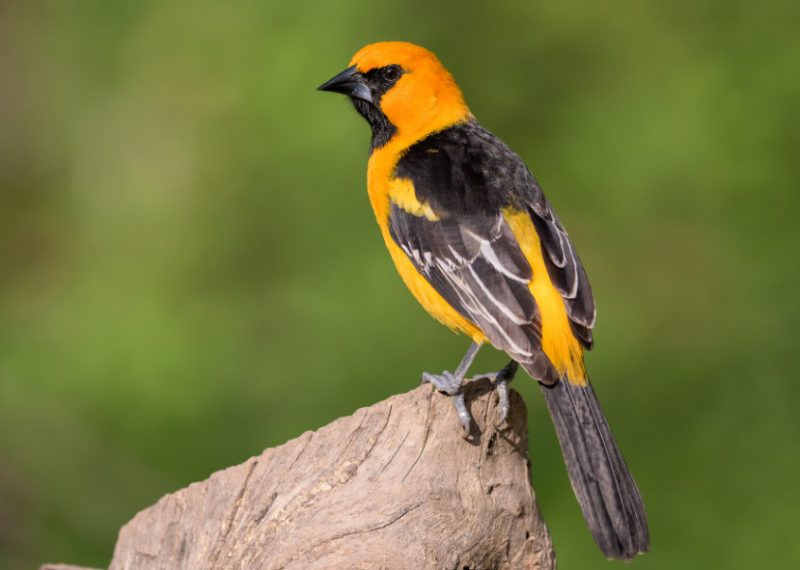
The Altamira Oriole is a striking tropical bird known for its vivid orange-yellow body contrasted by a black throat, back, and wings. It is the largest oriole species in the United States, measuring about 9 inches long. Both sexes look similar, with bright plumage and long tails that make them easy to spot in the South Texas brushlands.
Its song is rich and musical, composed of slow, flutelike notes and chattering calls. Altamira Orioles are less restless than smaller species, moving methodically through trees in pairs or small family groups. They are often seen near feeders offering fruit or nectar.
Their diet consists of insects, fruit, and nectar, and they are known for building extraordinary woven nests that hang up to two feet long from tall branches. These nests are often reused or rebuilt in the same area year after year.
In Texas, the Altamira Oriole is a year-round resident, found mainly in the Lower Rio Grande Valley. It thrives in subtropical woodlands, thorn forests, and riparian areas, particularly where native trees like mesquite and ebony grow.
Audubon’s Oriole (Icterus graduacauda)
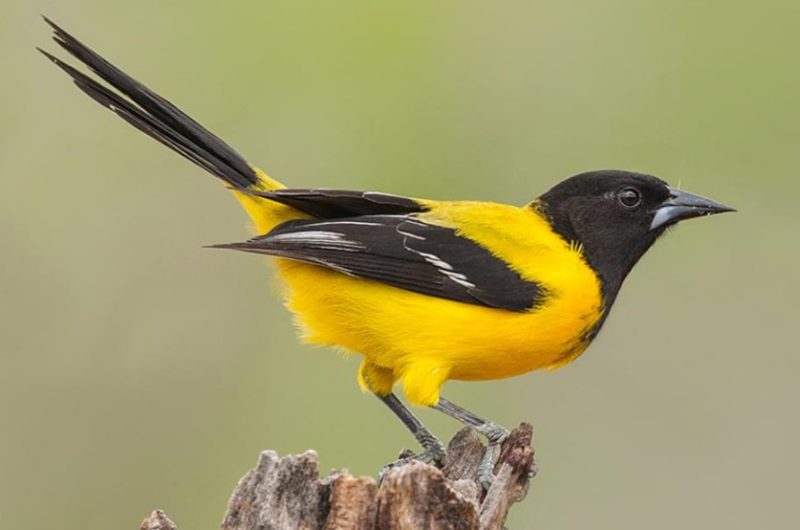
Audubon’s Oriole is a beautiful bird with a bright yellow body, black head, and black tail. Unlike other orioles, its back and wings are olive-green, creating a softer contrast. It measures about 8 inches long and has a full, rounded body and a long tail. Both males and females share similar plumage, though males are slightly brighter.
This oriole has a rich, melodious song that consists of clear, whistled phrases repeated in slow, rhythmic patterns. Its calm and deliberate behavior makes it less conspicuous than flashier oriole species. It often forages quietly through foliage or visits feeders for fruit and suet.
Audubon’s Orioles feed mainly on insects, berries, and nectar, occasionally catching small prey from leaves or flowers. Their nests are finely woven, suspended in dense shrubs or trees. They are monogamous and maintain strong pair bonds, often returning to the same territory each year.
In Texas, this species is restricted to the southern parts of the state, especially in the Lower Rio Grande Valley and adjacent brushlands. It prefers dense woodland and thorn forest habitats and is a year-round resident of this subtropical region.
Western Kingbird (Tyrannus verticalis)
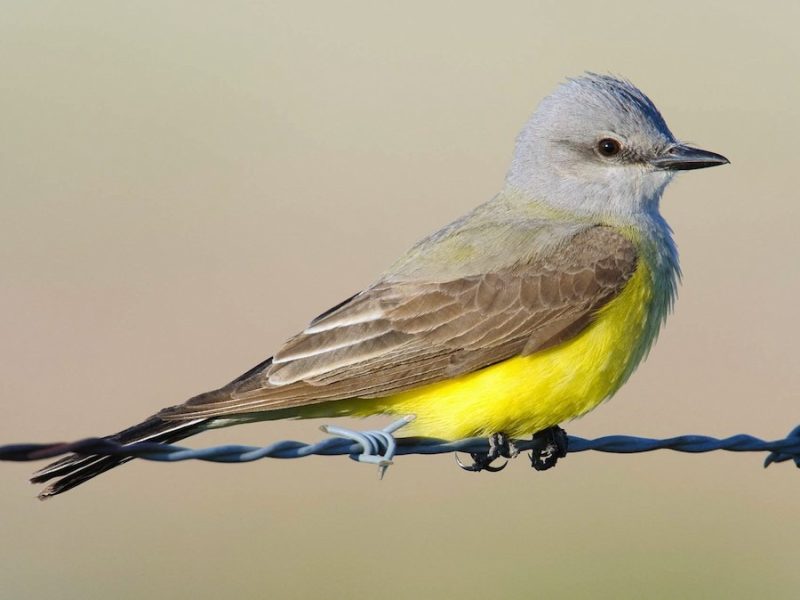
The Western Kingbird is a bold and striking flycatcher with a pale gray head, white throat, and bright yellow belly. Its wings are dark gray, and the tail is black with a distinct white outer edge. Measuring about 9 inches long, this bird displays a confident posture often seen perched on fences, wires, or shrubs in open country.
It is easily recognized by its sharp “kip” calls and its aggressive aerial displays when defending territory. Western Kingbirds are fearless and will chase away much larger birds, including hawks and crows. They are excellent fliers, capable of quick, acrobatic maneuvers when catching insects mid-air.
Their diet consists mostly of flying insects such as bees, wasps, and beetles, though they also eat fruit and berries during late summer. These birds are active, territorial, and very protective of their nesting sites, which are usually built in trees, utility poles, or other elevated spots.
In Texas, Western Kingbirds are common during spring and summer, breeding throughout the western and central parts of the state. They prefer open habitats like grasslands, agricultural fields, and desert edges and migrate south to Mexico and Central America in winter.
Couch’s Kingbird (Tyrannus couchii)
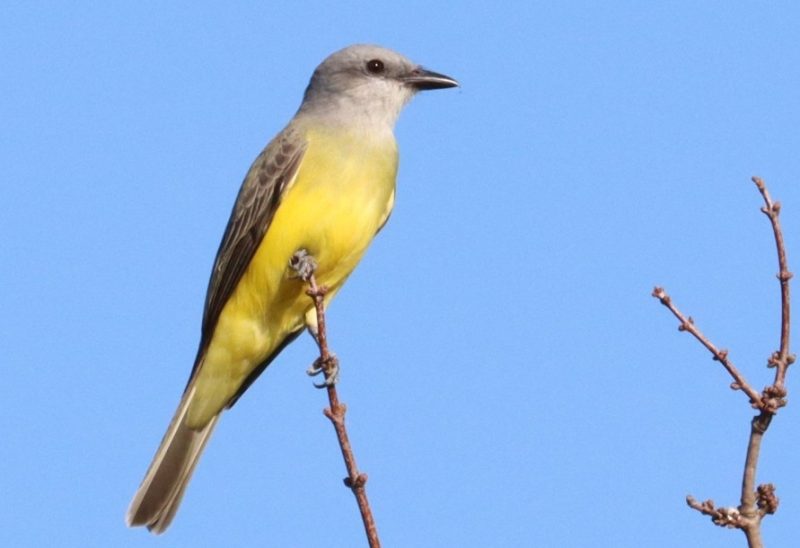
Couch’s Kingbird is a tropical flycatcher known for its bright yellow underparts, olive-green back, and gray head. It closely resembles the Tropical Kingbird but can be distinguished by its sharper, more explosive call, often described as “kip-BREEer.” It measures about 8.5 inches long with a large, sturdy bill and slightly notched tail.
This bird is bold and vocal, often perching on exposed branches or power lines to hunt for insects. Its flight is direct and powerful, with frequent sallies to catch prey in midair. During breeding season, males perform fluttering displays and chase intruders from their territory.
Couch’s Kingbirds primarily eat flying insects, though they also consume small fruits and berries. They are often seen sallying out from perches to snatch prey before returning to their lookout. Their nests are made of twigs and grass, built in trees near open areas or water.
In Texas, Couch’s Kingbirds are mostly found in the southern and southeastern regions, particularly in the Rio Grande Valley and coastal plains. They are year-round residents in South Texas, favoring open woodlands, pastures, and riverine habitats.
Tropical Kingbird (Tyrannus melancholicus)
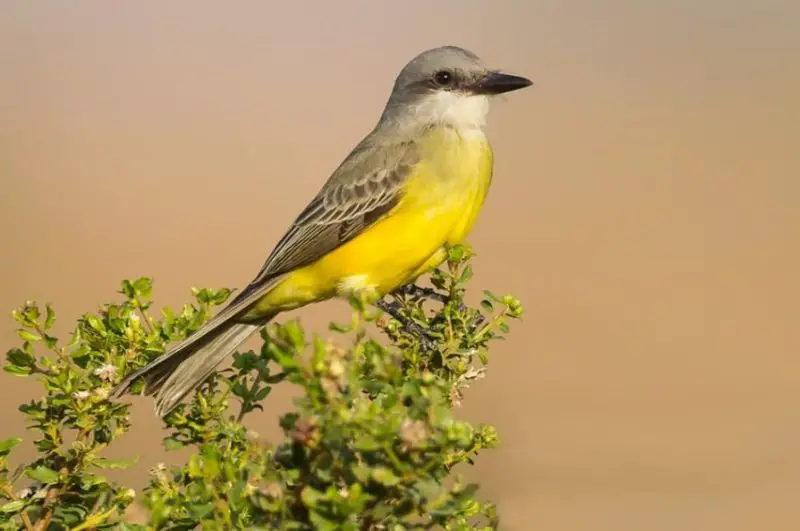
The Tropical Kingbird is a large, bright flycatcher with a lemon-yellow belly, olive back, and gray head with a faint mask. Its tail is long and slightly forked, and its overall length is about 8.5 to 9 inches. The species is almost identical to Couch’s Kingbird, but its voice is softer, with a rapid “pit-see-er” call that helps birders distinguish it.
It is often seen perched on wires or treetops, scanning the air for insects. Tropical Kingbirds are aggressive defenders of their nests and will dive at larger birds or even humans if they come too close. Their hunting technique involves quick, graceful flights to snatch insects from the air before returning to the same perch.
Their diet includes flying insects such as grasshoppers, bees, and dragonflies, along with small fruits during the non-breeding season. They are known to hunt in open spaces, from pastures to suburban areas, especially near water.
In Texas, Tropical Kingbirds are uncommon but can be found in far southern regions, particularly in the Lower Rio Grande Valley. They are typically seen near woodlands, parks, and river corridors, often coexisting with Couch’s Kingbirds in overlapping ranges.
Great Kiskadee (Pitangus sulphuratus)
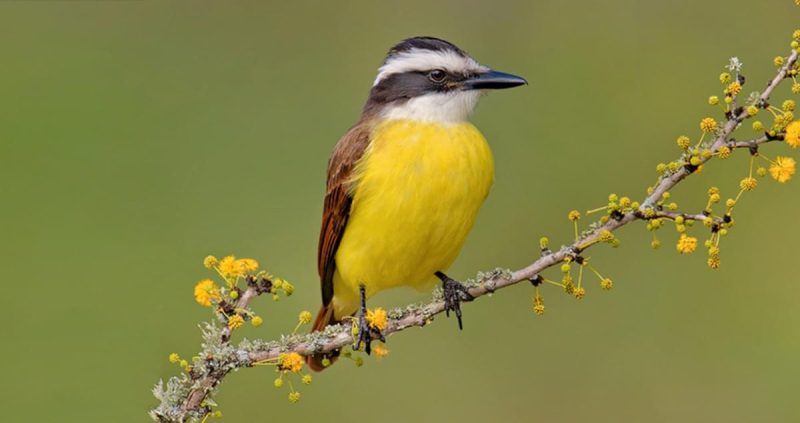
The Great Kiskadee is one of the most colorful and charismatic flycatchers in Texas, with a bright yellow belly, reddish-brown wings, and a bold black-and-white head pattern. A hidden yellow crown patch becomes visible when it raises its crest. It is about 9 inches long and has a thick, black bill used for a wide variety of foods.
Its loud, distinctive call — “kis-ka-dee!” — gives the bird its name. The Great Kiskadee is highly social and bold, often seen in pairs or small groups perched near water, trees, or buildings. It is not shy around humans and frequently visits feeders or gardens.
Unlike most flycatchers, this species is omnivorous. It eats insects, small vertebrates, fruits, and even fish, diving briefly into shallow water to catch prey. It builds bulky dome-shaped nests with side entrances, often placed high in trees or on man-made structures.
In Texas, the Great Kiskadee is found mainly in the southernmost regions, particularly the Lower Rio Grande Valley. It thrives in riparian woodlands, parks, and urban areas, and is a year-round resident of South Texas’ subtropical climate.
Western Tanager (Piranga ludoviciana)
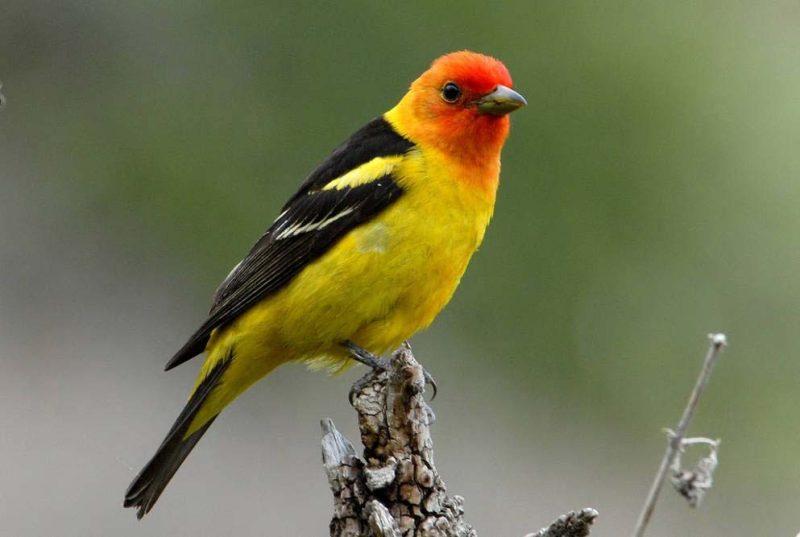
The Western Tanager is a strikingly beautiful songbird, with males displaying a bright yellow body, black wings, and a fiery red-orange head. Females are olive-yellow with dusky wings and lack the bright red head. It measures about 7 inches long and has a stout bill well-suited for eating both insects and fruit.
Its distinctive coloration makes it easy to identify, especially during migration when males are at their most vibrant. The song is a series of short, burry phrases resembling that of a robin but slightly hoarser. Western Tanagers are shy and often remain high in the forest canopy, moving deliberately among branches.
They primarily eat insects during the breeding season and shift to berries, fruits, and nectar during migration. They catch insects on the wing or glean them from leaves. Nests are cup-shaped, built high in conifers from twigs and grasses.
In Texas, Western Tanagers are migratory visitors seen mostly in spring and fall. They pass through western, central, and northern parts of the state, favoring open woodlands, forest edges, and parks. Occasionally, they winter along the southern Texas coast where food is abundant.
Summer Tanager (Piranga rubra)
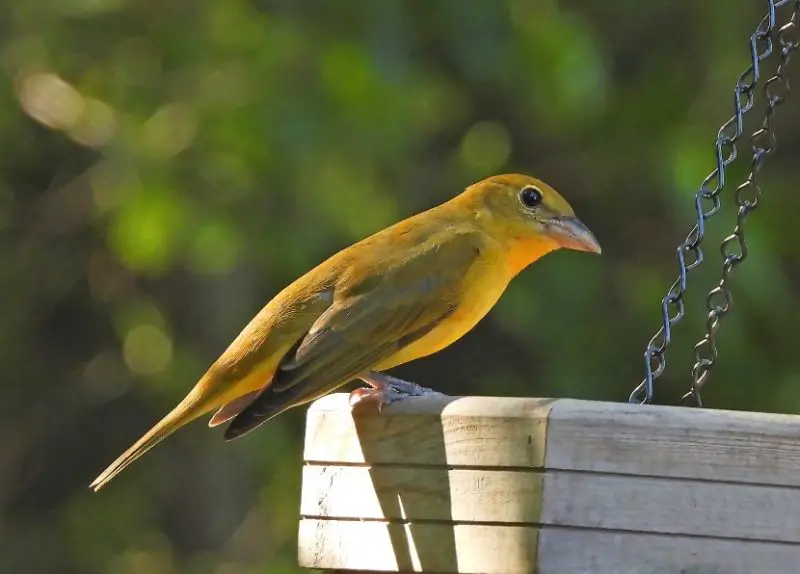
The Summer Tanager is a stunning songbird known for its brilliant, solid-red plumage in males, while females and immature birds are golden-yellow with olive tones. It is medium-sized, about 7 inches long, with a thick, blunt bill adapted for catching insects. Its bright coloration and calm demeanor make it a favorite among birdwatchers across Texas.
This species is best recognized by its sweet, whistled song, similar to that of a robin but softer and slower. Summer Tanagers are often seen perched high in treetops, scanning for flying insects. They are especially skilled at catching bees and wasps, removing the stingers before eating them — a unique trait among songbirds.
Their diet consists primarily of flying insects during summer, but they also feed on fruits and berries during migration and fall. They build cup-shaped nests high in deciduous trees, typically hidden in dense foliage.
In Texas, the Summer Tanager is a common breeding bird throughout the eastern and central regions, including oak and pine forests, wooded parks, and river valleys. They migrate to Central and South America for the winter, returning to Texas each spring to breed.
Dickcissel (Spiza americana)
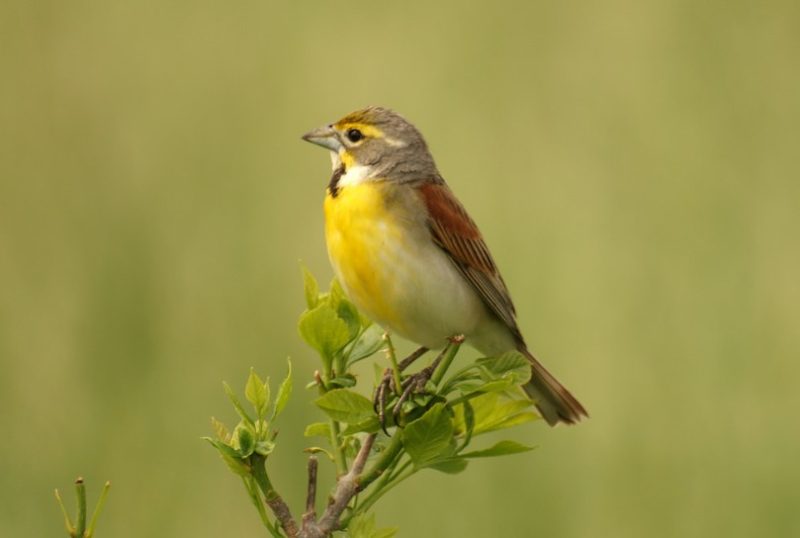
The Dickcissel is a small, sparrow-like bird with a bright yellow chest and a bold black “V” on its throat. Males have a gray head and rusty shoulders, while females are paler and lack the black bib. Measuring about 6 inches long, this species resembles a miniature meadowlark but has a thicker bill suited for seed eating.
It is easily recognized by its sharp, repetitive “dick-dick-ciss-ciss-ciss” song, often sung from tall grasses or fence posts. Dickcissels are highly social and often form large flocks outside the breeding season. During summer, males defend small territories with persistent singing.
They feed mainly on seeds and insects, with grasshoppers, beetles, and caterpillars making up a large part of their diet during the breeding season. Nests are built low in dense vegetation, usually concealed in grass or shrubs.
In Texas, Dickcissels are abundant in the central and eastern regions during summer, particularly in prairies, hayfields, and agricultural areas. They migrate to Central and South America for winter, often appearing in large flocks before departure.
Yellow-throated Vireo (Vireo flavifrons)
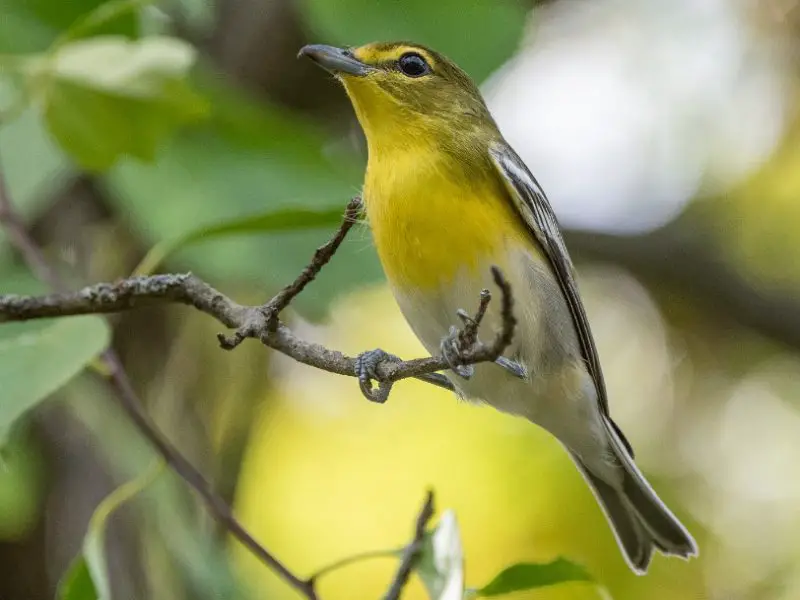
The Yellow-throated Vireo is a small, robust songbird with a striking yellow throat and breast, olive-green back, and two bold white wing bars. Its eyes are surrounded by bright yellow “spectacles,” giving it a distinctive facial expression. It measures about 5.5 inches long and has a thick bill typical of vireos.
This species has a slow, deliberate song composed of sweet, burry phrases such as “three-eight” or “see-you.” It forages calmly among tree branches, gleaning insects from leaves, often remaining still for long periods — a behavior that contrasts with the restlessness of warblers.
Yellow-throated Vireos primarily eat insects, spiders, and caterpillars, occasionally adding berries to their diet. They are known for their tidy, hanging cup nests woven from grass and lichen, usually suspended from high tree branches.
In Texas, this vireo breeds mainly in the eastern parts of the state, where mature hardwood forests and woodland edges provide ideal habitat. During migration, they can also be found statewide, especially in wooded parks and riparian corridors.
White-eyed Vireo (Vireo griseus)
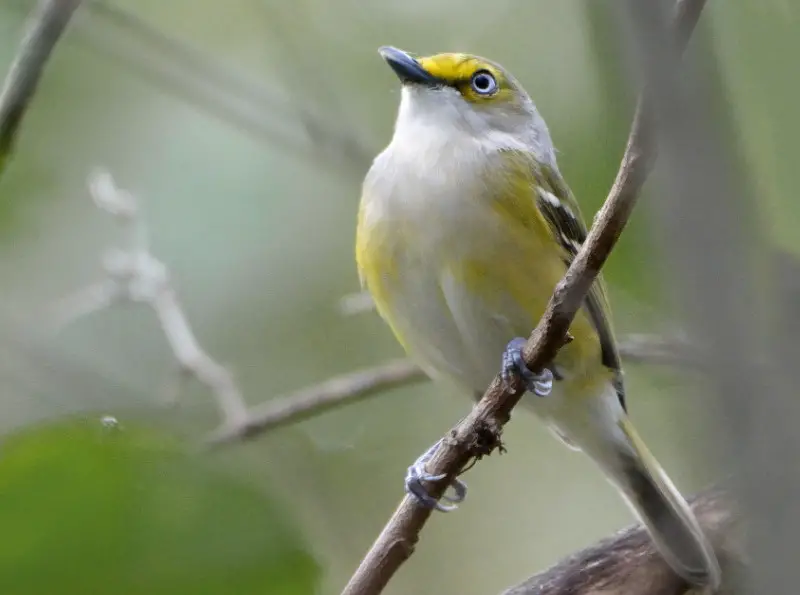
The White-eyed Vireo is a small, active bird with olive-green upperparts, yellow flanks, and a white belly. Its bright yellow spectacles encircle striking white eyes — a key field mark that gives the species its name. It measures around 5 inches long and has a short, thick bill ideal for foraging in dense shrubs.
Its song is a lively mix of sharp, jerky notes and phrases, often described as “chick-a-rio-chick!” The White-eyed Vireo is secretive and prefers to stay hidden in thickets, occasionally darting into the open before disappearing again into vegetation.
This species feeds on insects, spiders, and berries, frequently flicking its tail as it forages among shrubs and vines. During breeding, it builds a small, suspended cup nest from grasses, plant fibers, and spider silk, carefully hidden in low shrubs.
In Texas, the White-eyed Vireo is common and widespread, especially in the eastern and southern regions. It thrives in brushy fields, forest edges, and riparian zones and is a year-round resident in much of the state, though northern populations migrate south for winter.
Blue-winged Warbler (Vermivora cyanoptera)
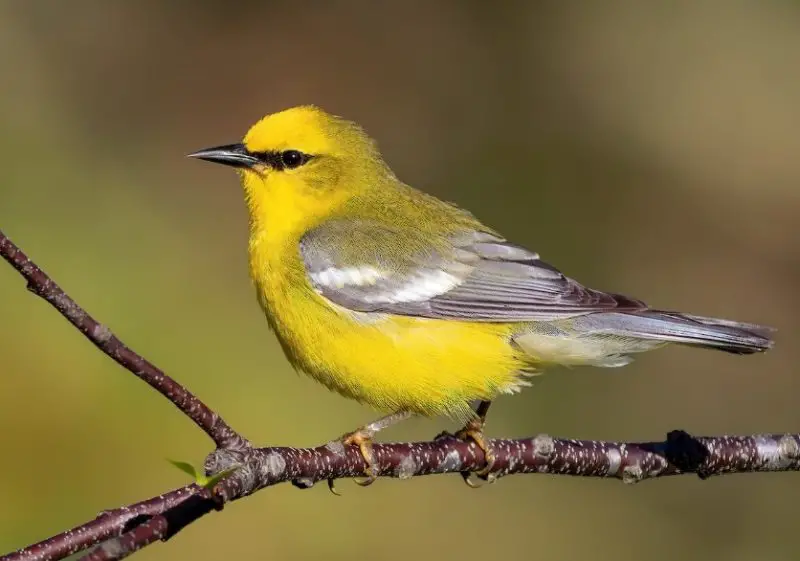
The Blue-winged Warbler is a small, colorful bird featuring a bright yellow head and underparts, olive-green back, and bluish-gray wings with bold white wing bars. A thin black eye line gives it a sharp, alert look. It measures about 4.75 inches long and moves quickly through foliage in search of insects.
Its song is a distinctive two-part “bee-buzz” that is easy to recognize once learned. Blue-winged Warblers are energetic and curious, often flitting low in shrubs or small trees. They occasionally hybridize with the Golden-winged Warbler, producing birds known as “Brewster’s” or “Lawrence’s” warblers.
Their diet consists mainly of caterpillars, beetles, and other small insects, which they glean from leaves or capture in short aerial flights. They build compact cup nests on or near the ground, concealed among grasses and low vegetation.
In Texas, the Blue-winged Warbler is primarily a migrant, passing through the eastern parts of the state during spring and fall. They favor shrubby areas, forest edges, and young regenerating woodlands, stopping briefly before continuing their journey to breeding grounds in the Midwest and Appalachians.
Magnolia Warbler (Setophaga magnolia)
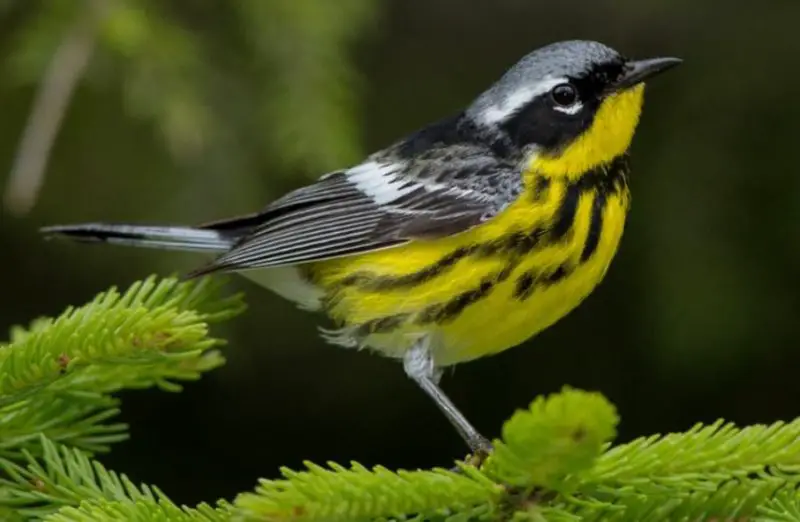
The Magnolia Warbler is a small, vibrant bird with striking plumage that makes it one of the easiest warblers to identify. Males have a bright yellow breast streaked with bold black lines, a black necklace, and a gray back with white wing patches. Females are duller but share similar patterns. Measuring about 4.5 inches long, this warbler is both colorful and active.
Its song is a short, sweet trill, often described as “weeta-weeta-weetsee.” Magnolia Warblers are energetic foragers, flitting through trees and shrubs to catch insects. They are frequently seen flicking their tails to reveal white patches underneath — a characteristic behavior of this species.
Their diet consists mainly of small insects and spiders, which they glean from foliage or snatch in midair. During migration, they occasionally visit gardens or forest edges to feed. Nests are built in dense conifers, well-hidden from predators.
In Texas, the Magnolia Warbler is a common migrant during spring and fall, particularly in the eastern half of the state. They prefer wooded areas, forest edges, and parks where insects are plentiful, continuing southward to Central America for winter.
Nashville Warbler (Leiothlypis ruficapilla)
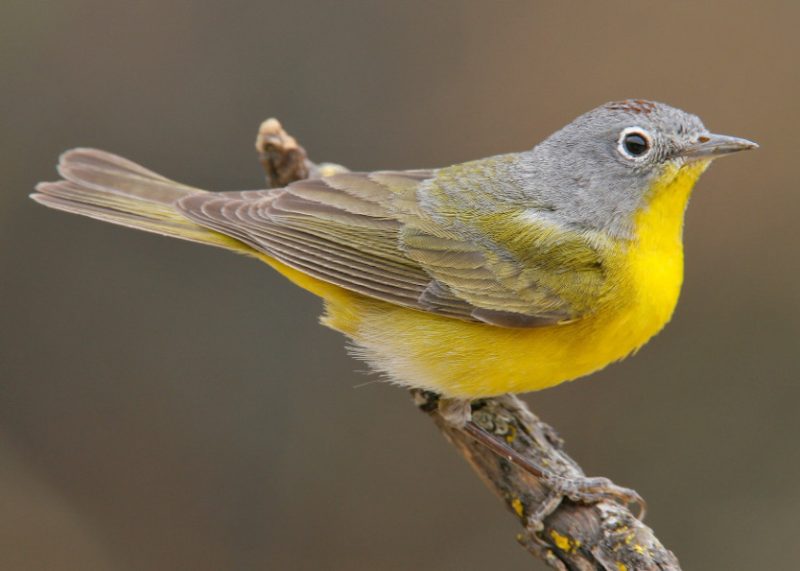
The Nashville Warbler is a dainty, olive-backed bird with a bright yellow breast, gray head, and a faint white eye ring. A subtle chestnut crown patch can be seen when the feathers are raised. It measures about 4.5 inches long and has a short, thin bill adapted for catching insects.
Its song is a high, two-part trill that rises and falls in pitch. Nashville Warblers are often found low in shrubs or young trees, actively flitting about in search of food. They are shy but curious, frequently flicking their tails and wings while foraging.
Their diet is primarily insect-based, including caterpillars, leafhoppers, and beetles, though they also eat small berries during migration. They nest close to the ground in thick vegetation, constructing cup-shaped nests lined with fine grasses and hair.
In Texas, the Nashville Warbler is a common migrant, especially during spring and fall. They pass through most of the state, favoring open woodlands, brushy fields, and forest edges. Many linger for short periods before continuing to wintering grounds in Mexico and Central America.
Canada Warbler (Cardellina canadensis)
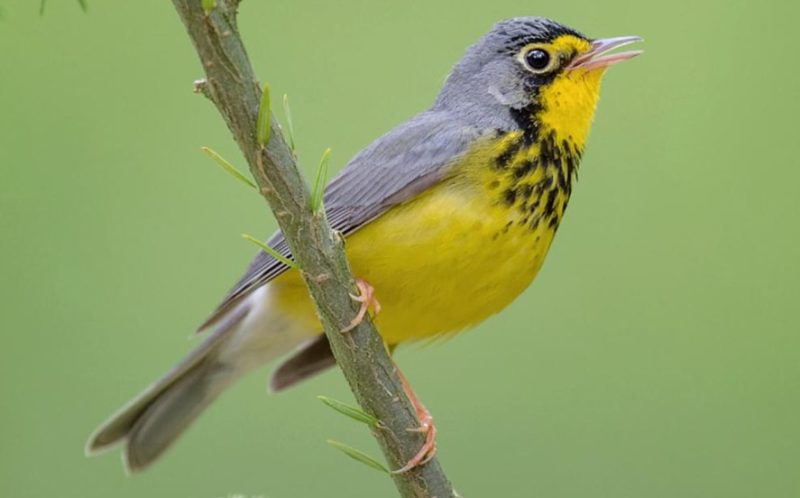
The Canada Warbler is a stunning songbird with a bright yellow underbody, slate-gray upperparts, and a distinctive black “necklace” of streaks across the breast. Its bold white eye ring gives it a wide-eyed look, earning it the nickname “necklaced warbler.” It measures about 5 inches long and moves swiftly through forest undergrowth.
Its song is a quick, musical series of chirps and whistles, often delivered from concealed perches. Canada Warblers are highly active, darting among leaves and branches as they hunt insects. Their constant motion and contrasting colors make them easy to spot during migration.
They feed mainly on insects, including flies, moths, and beetles, and occasionally eat small spiders. Their nests are built low to the ground in mossy areas, often near streams or damp woodlands.
In Texas, the Canada Warbler is an uncommon but regular migrant, mostly observed in the eastern regions during spring and fall. They prefer moist forests, thickets, and riparian corridors before continuing south to the Andes of South America for winter.
Kentucky Warbler (Geothlypis formosa)
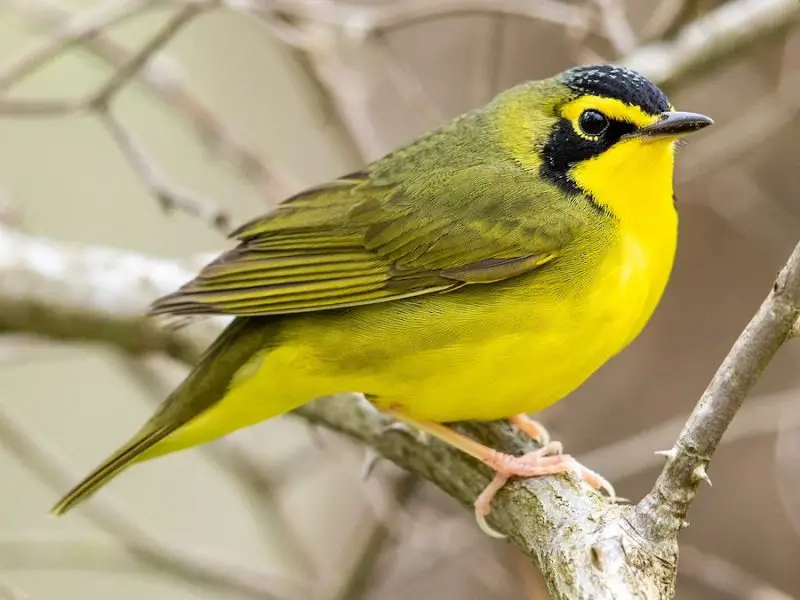
The Kentucky Warbler is a striking ground-dwelling warbler with a bright yellow underside, olive-green back, and bold black markings on its face resembling a mask. Males display a more defined black cap and sideburns, while females are slightly duller. It measures about 5.5 inches long and moves deliberately through dense forest understory.
Its song is a loud, rolling “churree-churree-churree” that echoes through hardwood forests. Kentucky Warblers prefer to stay hidden in thickets, rarely venturing into open areas. Their secretive behavior and preference for shady habitats make them more often heard than seen.
They feed primarily on insects, spiders, and other small invertebrates found on the forest floor. Nests are usually placed on or near the ground, concealed among ferns, leaves, or dense vegetation.
In Texas, Kentucky Warblers are summer residents mainly in the eastern part of the state. They breed in moist, mature forests with dense understory and migrate to Central America during winter. They are best observed in spring when males are actively singing.
Prairie Warbler (Setophaga discolor)
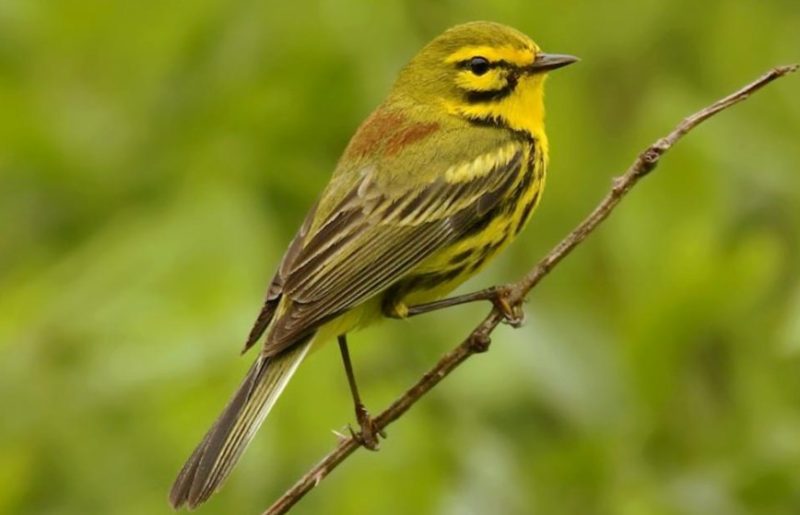
The Prairie Warbler is a small, slender bird with a bright yellow face and breast accented by bold black streaks on the sides. Its back is olive-green with reddish streaks on the upper back, especially in males. Measuring about 4.5 inches long, it has a constantly flicking tail that reveals white outer feathers in flight.
Its song is a rising series of buzzy notes, often described as “zee-zee-zee-zee,” which helps locate it among dense brush. Prairie Warblers are active and curious, often seen hopping among low shrubs and small trees. They prefer open, scrubby habitats over dense forests.
Their diet consists mainly of insects such as caterpillars, beetles, and spiders, though they also eat small berries. Nests are compact cups built low in shrubs or saplings, often hidden among dense foliage.
In Texas, Prairie Warblers are most common during migration, particularly in the eastern and coastal regions. They occasionally breed in the northeast of the state where suitable shrubby habitats exist, then migrate south to the Caribbean and Central America for winter.
Tips for Spotting Yellow-Breasted Birds in Texas
Learn Their Songs and Calls
Many yellow-breasted birds can be identified more easily by sound than sight, especially in dense foliage. For example, the Western Kingbird’s sharp “kip,” the Hooded Warbler’s ringing “ta-wit ta-wit tee-yo,” and the Common Yellowthroat’s “witchety-witchety” song are distinct clues. Spend time listening to bird recordings before heading out, so you can recognize species by ear even when they’re hidden.
Visit the Right Habitats
Texas offers diverse landscapes that host different yellow-breasted species. Eastern and coastal forests attract warblers and vireos, while grasslands and open fields are preferred by meadowlarks and kingbirds. In South Texas, tropical orioles and kiskadees can be found in brushlands and riparian areas. Visiting the right habitat greatly increases your chances of spotting specific species.
Go Birding During Migration Seasons
Spring (March to May) and fall (September to October) are prime times to observe yellow-breasted birds in Texas. Many warblers, vireos, and tanagers pass through the state on their way between North and South America. Early morning hours are best, as birds are most active and lighting conditions are ideal for viewing their bright plumage.
Bring Binoculars and a Field Guide
High-quality binoculars help you distinguish subtle features like wing bars, eye rings, and streak patterns. A Texas-specific bird field guide or birding app will also help with quick identification in the field. Apps like Merlin or eBird can even play bird calls and show local sighting hotspots.
Be Patient and Observant
Many yellow-breasted birds are small, quick, and secretive. Move slowly and quietly through habitats, watching for flashes of yellow or flicking tails. Focusing on movement and listening for calls will often reveal birds that blend into their surroundings.
FAQs About Yellow-Breasted Birds in Texas
What is the most common yellow-breasted bird in Texas?
The Western Kingbird is among the most commonly seen yellow-breasted birds across Texas, especially in open fields and along fences during spring and summer. The Common Yellowthroat is also widespread in wetlands and brushy areas.
Where is the best place to see yellow-breasted warblers in Texas?
East Texas forests, the Gulf Coast, and riparian corridors are top birding areas for warblers during migration. Parks such as High Island, Sabine Woods, and Brazos Bend State Park are famous for attracting large numbers of migrating yellow-breasted warblers.
When is the best time of year to find yellow-breasted birds?
Spring and fall migration seasons are ideal, as both resident and migratory birds are active and colorful. Summer months are also excellent for spotting breeding species like the Summer Tanager, Eastern Meadowlark, and Great Kiskadee.
Do yellow-breasted birds stay in Texas year-round?
Some species, like the Altamira Oriole, Audubon’s Oriole, and Great Kiskadee, are year-round residents of southern Texas. Others, such as most warblers and tanagers, migrate south in winter to warmer climates in Mexico and Central America.
What should I feed yellow-breasted birds if I want to attract them?
To attract them to your yard, offer fruit, nectar, and insects. Orioles and tanagers enjoy orange slices and jelly, while kingbirds and kiskadees are drawn to areas rich in flying insects. Providing native trees and shrubs will also create a natural food source and shelter.
Are yellow-breasted birds easy to photograph?
Yes, many species perch in open areas or visit feeders, making them excellent photography subjects. Early morning light highlights their yellow plumage beautifully. Patience and a telephoto lens will help capture close-up shots without disturbing them.

